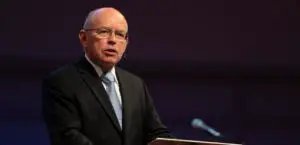Stories communicate.
Just look at your local bookstore. It’s filled with stories. Consider the classic books by Dickens, Lewis, Tolkien, and Sayers. They continue to gain new generations of readers. Their stories communicate.
So do the biblical stories. They communicate an eternal message that remains equally true for each generation. The message that the Holy Spirit inspired writers intended for B.C. generations continued in the A.D. generations.
Yet having preached for several decades, I still find preaching narratives—particularly the Old Testament narratives—daunting. My struggle is two-fold. First, I don’t want to botch the story by imposing a different preaching genre upon a narrative. In other words, while my comfort zone might be preaching from an epistle or Gospel, I must not approach an OT narrative in the same way. Biblical genres are inspired too.
Second, I want to make sure that I understand how the OT narrative points to Jesus Christ. All of Scripture is about Jesus (John 5:39). So I don’t want to be guilty of preaching a sermon that would be welcomed in a modern synagogue because it simply moralizes or considers history without clearly pointing to Jesus Christ as the Messiah.
The biblical stories tell the great, overriding Story of Scripture—the message of Jesus Christ, the Son of God sent as the Redeemer. But how do we preach Christ from these narrative texts? Let’s think about that by considering the book of Esther.
Letting Narratives Speak
I had long enjoyed reading the book of Esther but had never preached from it until a few weeks ago. So in preparation to expound the book I wrestled for several months on how to go about it. I’ve heard some moralizing sermons on Esther’s courage but that missed the writer’s message. I realized that I could easily fall into the same trap. Here are some of the things that I found helpful in preaching Christ through the book of Esther.
- Let the story speak. What I mean is to remember that it is biblical story that you are seeking to preach, so don’t get in the way of the story by trying to deal with each sentence or encumbering it with too much added structure.
- Maximize the public reading of the text. Beware of thinking you must hurry through your reading in order to get to the sermon. The power of hearing the biblical writer’s story impacts the audience. It’s not just story—it’s God’s Word.
- Beware of moralizing. I have a book on Esther by a now deceased expositor, noted for his faithfulness in preaching the Word. But as I read through several of his sermons on Esther, disappointingly, I found that he moralized and “devotionalized” rather than let the message of Esther show through.
- Read and re-read the text to determine the writer’s purpose. I found this most helpful. Then as the Spirit inspired purpose is determined, stick to it throughout your sermons. In the case of Esther, the message of God’s providence at work to redeem a people for himself shined through. So my goal each week has been to let that message dominate my sermon.
- Don’t be trapped into thinking that you must do verse-by-verse exposition in an OT narrative. If you attempt it you will sink. Now, if you’re preaching through Romans do the verse-by-verse study. But the narrative genre does not lend itself to that approach. It’s a theological story so treat it like a theological story.
- Look for turns in the story. By that, good writers—like that of Esther—let the story unfold. I’ve often tried to read Esther as though I did not know the end of the story. In that way, I get a better sense of the rhythm that its writer utilizes as he tells the story. My sermon should follow that same kind of rhythm with all of the crescendo, pathos, and movement found in the text.
- Let the humanity shine through. Esther is no love story or poor girl meeting prince charming. Against her will and that of her guardian Mordecai, she’s taken into the harem of a ruthless, debauched king of the most powerful empire on the face of the earth. That’s not a pretty picture. Let it shine through. Esther went through the ugliness of human depravity to become an instrument in God’s hands—let that message be clear. It shows the grace of God in every setting.
- Make good use of background material. Never assume that the congregation understands the significance of the exile in Persia or the power of an ancient monarchy or the bitterness of ingrained prejudice. Paint the picture by availing yourself of background resources. I never realized that my second-hand purchase of Herodotus would be so useful in preaching to my congregation!
- Stick to the main point that the inspired writer seeks to make. It’s not the preacher’s job to improve upon the inspired purpose. That purpose is quite sufficient, so understand it and turn neither to the right nor the left.
- Maintain suspense in the sermon that reflects the suspense in the text. The sermon needs to mirror the narrative text. Match pathos for pathos, fear for fear, unknown for unknown, joy for joy. In that way, the hearers better identify with the biblical text.
- Preach Christ from each narrative text. If we believe that all of Scripture points to Christ then our responsibility is to labor until we see how a particular OT text does so. With narratives, it’s generally not an allegory or parable that speaks of Christ but the overall grand picture in the story. So in Esther, if Haman’s plan had succeeded in annihilating the Jews, coupled with their destruction would be the failure of God’s promises for the Messiah. That message runs throughout the narrative.
Much more can be said about narrative preaching. So I suggest consulting Dale Ralph Davis, The Word Became Fresh: How to Preach from Old Testament Narrative Texts (Mentor, 2006), Richard L. Pratt Jr., He Gave Us Stories: The Bible Student’s Guide to Interpreting Old Testament Narratives (Wolgemuth & Hyatt, 1990), and Edmund P. Clowney, Preaching Christ in All of Scripture (Crossway, 2003). I trust that you will find joy, as will your hearers, as you preach Jesus Christ from the OT narratives.






















